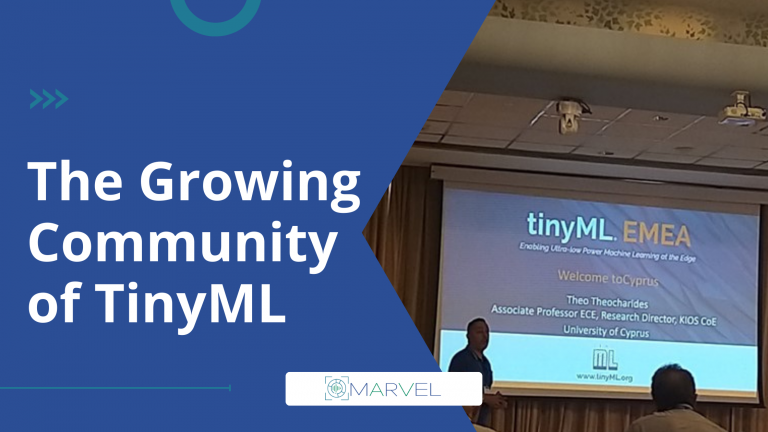The Growing Community of TinyML
TinyML is an emerging field that combines the power of machine learning with the capabilities of tiny, low-power microcontrollers. It’s an exciting area that’s growing rapidly, with new developments and innovations emerging all the time.
Bringing artificial intelligence and machine learning to the edge, i.e., to the IoT end-devices, poses several challenges, such as dealing with:
- Limited processing power and memory: AI models must be designed to be as efficient as possible, with minimal computation and memory requirements. Researchers must develop new techniques and algorithms optimized for these devices’ hardware constraints and methods for compressing and quantizing models to reduce their size while maintaining accuracy.
- Data scarcity and sensor noise: TinyML models can rely on small amounts of data, as the devices on which they are deployed have limited storage and bandwidth. Or sensors can have heterogeneous quality in terms of accuracy, resolution, size, and range, challenging the development of accurate models. To obtain models that are accurate and robust, it is worth exploring new techniques for training models with limited data (e.g., transfer learning, data augmentation) and/or handling noisy data (e.g., filtering, denoising, etc.)
- Real-time constraints: Many TinyML applications require real-time processing. It can be challenging and pushes the research towards efficient AI models.
- Limited debugging tools: Researchers must develop new debugging techniques that are optimized for the hardware constraints of these devices.
In 2013, a non-profit professional organization called tinyML Foundation was born, “focused on supporting and nurturing the fast-growing branch of ultra-low power machine learning technologies and approaches dealing with machine intelligence at the very edge of the cloud”.
One of the most exciting things about TinyML is the growing community of developers, engineers, and enthusiasts that are driving the field forward. This community is made up of individuals and organizations from around the world, all working together to explore the possibilities of TinyML.
At the heart of this community are the TinyML Meetups. FBK has, in particular, participated in tinyML EMEA Innovation Forum 2022 (some pictures below) and will also participate this June in the 2023 edition in Amsterdam. These are events that bring together TinyML enthusiasts to share their knowledge, learn from each other, and collaborate on new projects. In 2022, we presented the work done in MARVEL to anonymize video with face swapping on a low-power resource-constrained platform, such as the Kendryte k210 (Presentation at the event can be found here https://youtu.be/KECb8K3e23k). This year FBK will present some new advancements in tools to ease the development of tinyML models and a new interesting case study for people tracking– stay tuned
Another important part of the TinyML community is the online forums and discussion groups. These are places where people can share their ideas, ask for help, and collaborate on new projects. There are also online courses and tutorials available, which can help people learn the skills they need to get started with TinyML. See here https://www.youtube.com/@tinyML if you’re curious!
But, is the TinyML community only for researchers? Not at all! And this is demonstrated by the multiple companies sponsoring the TinyML Foundation initiatives. Big companies such as Infineon, STMicroelectronics, ARM, NXP, and Analog Devices, to name a few, which are big players in electronics and in sensors and microcontrollers production, are on board. But also many start-ups and SMEs.
Industries are interested in TinyML because it has the potential to transform a wide range of applications and enable new capabilities that were not previously possible. Here are a few reasons why industries are investing in TinyML:
- Low-power and low-cost: TinyML enables low-power and low-cost IoT devices to be smart and proactive. By embedding intelligence into a wide range of products and applications and making battery-powered or cost-constraints devices more powerful, IoT industries can make their product more attractive and versatile for expanding their market.
- Real-time processing: TinyML models can process data in real time, making it possible to enable new applications such as predictive maintenance, automated quality control, and real-time monitoring of equipment.
- Edge computing: TinyML is for at-the-edge deployment, where data is generated, allowing for faster decision-making and reduced latency. This is particularly important for applications that require real-time response, such as autonomous vehicles or industrial automation.
- Privacy: TinyML can enable privacy-preserving machine learning, where data is processed locally on the device without being sent to the cloud. This is particularly important for applications such as healthcare monitoring or home security, where privacy is a critical concern.
Overall, tinyML is an open and vast research field, and the growing community of TinyML enthusiasts is an exciting consequence that’s helping to push the boundaries of what’s possible with machine learning.
Blog signed by: FBK team
Menu
- Home
- About
- Experimentation
- Knowledge Hub
- ContactResults
- News & Events
- Contact
Funding

This project has received funding from the European Union’s Horizon 2020 Research and Innovation program under grant agreement No 957337. The website reflects only the view of the author(s) and the Commission is not responsible for any use that may be made of the information it contains.





